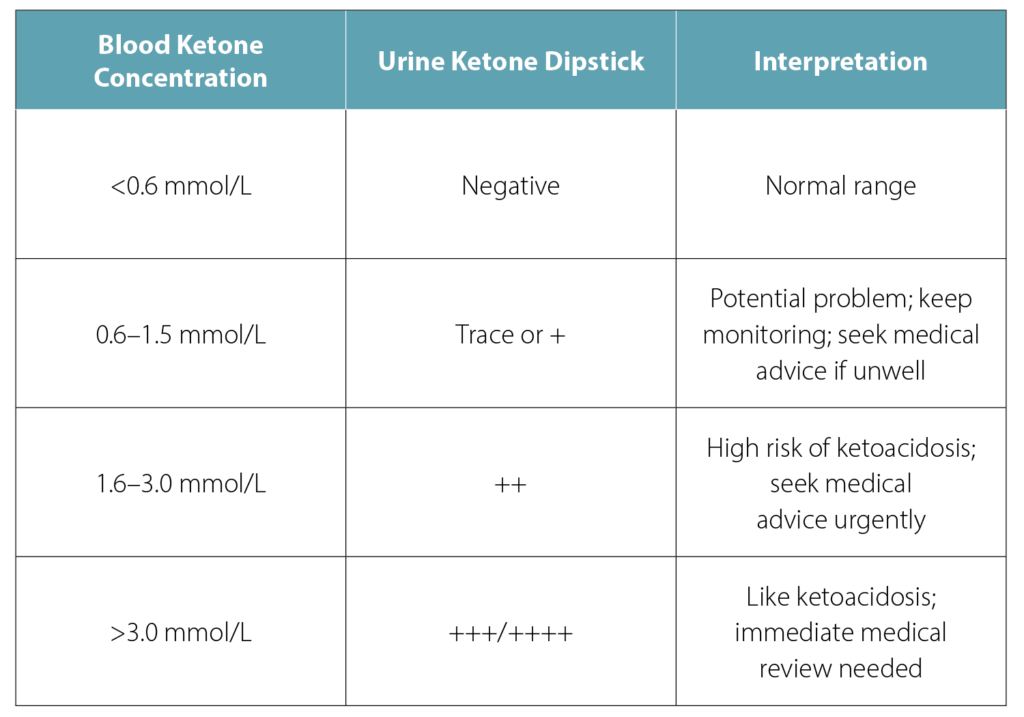Ketones can be like kryptonite for people with type 1 diabetes, and the symptoms of ketone build up are often what lead to the diagnosis of T1D. People are increasingly being diagnosed in what’s known as diabetic ketoacidosis (DKA), which can be life-threatening. Understanding what ketones are, how to measure ketone levels, and what to do when you have ketones is critical to managing T1D.
What are Ketones?
Ketones are a biproduct of the body burning fat for energy, and for people without diabetes, this is not a problem because their body will level out the ketones. Ketones commonly occur when people eat low carbohydrate diets, have diarrhea or vomiting, exercise strenuously, or during pregnancy. But when your body does not make insulin, ketones can build up and make your blood too acidic and can be a sign that you are not getting enough insulin.1
What are the symptoms associated with ketones for people with diabetes?
The most common symptoms for ketones are:1
- Nausea or vomiting
- Persistent high blood glucose levels*
- Fruity smelling breath
- Abdominal pain
- Lethargy or fatigue
- Confusion
- Short, rapid breathing
- Deep, labored, and gasping breathing (known as Kussmaul breathing)
*Except in the case of people taking SGLT-2 Inhibitors
When should you check Ketones?
It’s important to check for ketones whenever you have the symptoms above, especially the latter symptoms. Additionally, most diabetes care teams would recommend checking for ketones at the following times:2
- When your blood sugar is > 250 mg/dl (13.8 mmol/l) twice in a row
- When you are sick or injured
- If you’re going to exercise but your blood glucose is > 250 mg/dl (13.8 mmol/l)
If you’re taking an SGLT-2 Inhibitor, it’s usually recommended to monitor ketones more often due to the risk of what’s called Euglycemic DKA.3 Another time where increased ketone monitoring is recommended is during pregnancy for people with diabetes.
How do you measure Ketones?
You can currently measure ketones in two ways: urine or blood. The urine strips are easy to find, and you can purchase them over the counter at most pharmacies. The blood ketone test can be more accurate because urine can be hours old, but it is harder to get a blood ketone meter and test strips, and it’s more expensive. There are new ketone tests being developed, including a breath ketone analyzer that would be less invasive than the two techniques previously described.4
What level of Ketones is concerning?


A moderate to large level of ketones is concerning for people with diabetes, and it’s important to treat with sufficient insulin as well as hydration. Hydration is equally important for treating ketosis, and if you’re experiencing too much nausea or vomiting to stay hydrated, you may need to go get intravenous (IV) fluids.
If you’re experiencing ketones, it’s also a good idea to monitor blood glucose levels more closely than usual. You can do this by fingerstick, scanning an intermittent CGM, or looking at CGM values more often to make sure your blood sugars are coming down if they were high. Because high ketone levels can cause confusion, it’s also helpful to have a support person keeping an eye on you. It’s not worth risking your safety, and even if you have someone remotely monitoring your CGM values, or you’re texting someone with updates, this additional precaution will help keep you safe.
When in doubt, ask your healthcare team what their recommendations are for ketone management or sick day management. Hopefully, this will help you create a plan and a safety net so that managing ketones or illness is a little less stressful.
- Ketones in Urine
- Ketone Testing
- Ketones and Diabetes Fact Sheet
- Accuracy of a breath ketone analyzer to detect ketosis in adults and children with type 1 diabetes
Written and clinically reviewed by Marissa Town, RN, BSN, CDCES


